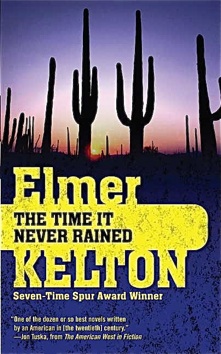Time for Another Hoover Commission?

The gist of the book is that scary adage, “Hi! I’m from the government, and I’m here to help you.” In making this point, Kelton follows the lives of the ranchers who accepted that government help as well as the only one who did not.
In the end, the sole rancher who refused aid ended up in better shape than all of those who accepted government help. Actually, two of those who participated in the government programs ended up in prison on convictions of fraud.
I began driving through San Angelo to visit my son and his family in Midland in the 1980s, about the same time I read The Time It Never Rained. By that time, the center of cotton production had shifted to the West Texas area of San Angelo to Lubbock.
In my early years, cotton was king here. Almost every non wooded area would be covered with row upon row of cotton. The space between each row was just wide enough for a horse and plow and for the farmers to walk along as they chopped weeds. The rows also had to accommodate those cotton sacks pulled by men, women, boys and girls, sometimes on their knees, at picking time.
The cotton fields in the San Angelo and Wahl area were not like that. There would be three or four rows planted in the old traditional way, then a wide open space with no vegetation. The open spaces were 2-1/2 to three times wider than the rows.
I assumed this new method of spacing was to accommodate modern planting, weed control, and harvesting equipment.
Then I met a cotton farmer from San Angelo and asked him about the peculiar spacing. He grinned a bit and said, “Those are the set aside acres.”
The farmer went on to explain that over production was driving cotton prices down. So here came that government agent to help. He began paying farmers to take acres of land out of growing cotton. He did not specify which acres were to be left fallow or planted to other crops.
Savvy farmers quickly learned that if they placed those set aside acres between the rows of cotton and fertilized all of the field, they were getting as much or more cotton as before. It seemed to my informant that each stalk of cotton had access to more fertilizer under the new method than when they were planted row upon row.
These two stories illustrate why there may be concern when the government says it is coming to help. Both examples involve the Department of Agriculture, one of the oldest in the federal hierarchy.
This department was created when the new country was an agricultural community. We transformed from that society into an industrial giant with small family farms being replaced with mega farms. So is there still a need for a Department of Agriculture?
Before going further with this, an admission is in order. Upon returning home after retirement from the Army, I benefited substantially from an Ag Department program. Under the guidance and assistance of Kermit Wahrmund and the late Willie Weiss of the Soil and Water Conservation office. I was able to prevent further erosion on a large part of the property. Because or through these efforts, I was honored as the Washington County “Resident Conservation Rancher” of the year in 1988.
Notwithstanding this personal benefit from the Department of Agriculture, I think some of its current functions might be more appropriate for other agencies. For example, why isn’t the school lunch program part of the Department of Education? Why isn’t meat inspection and food processing in the Department of Health and Human Services?
So here’s the perspective.
This short discussion of what might be called foibles by just one federal agency illustrates a growing problem. Highly paid bureaucrats constantly look for ways to expand their kingdoms. Food inspection relates to agriculture only because it involves agricultural products. Its main purpose, however, is to prevent or control infection or health problems.
So, as asked above, isn’t food inspection more a health problem than one of agriculture?
Likewise, the only connection between the school lunch program and education is that the food is scheduled for schools.
Does this mean that it is time for another Hoover Commission? This commission was officially named the Commission on Organization of the Executive Branch of the Government. It was appointed by President Truman in 1947 to recommend administrative changes in the government.
Most of the commission’s 273 recommendations were implemented by the mid 1950s. Consider, however, what happened in succeeding years. As could be expected, in the six decades since, the government’s topsy-turvy growth accelerated at an ever faster rate.
So let’s take another look at which federal programs are misaligned, which are duplicated, and which are past their need.
Just remember, though, that it would be much easier to disassemble the Washington Monument than to bury a government program that is more than a few days old.
That is why the Affordable Care Act is still wreaking havoc on the country.
enough





